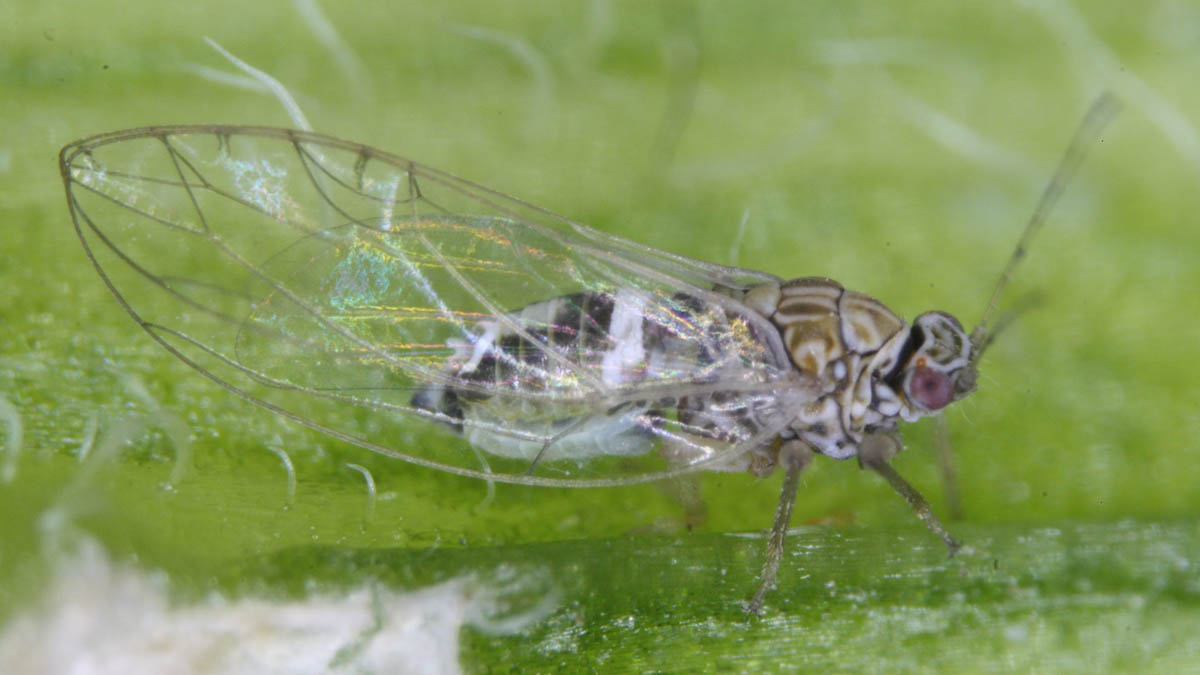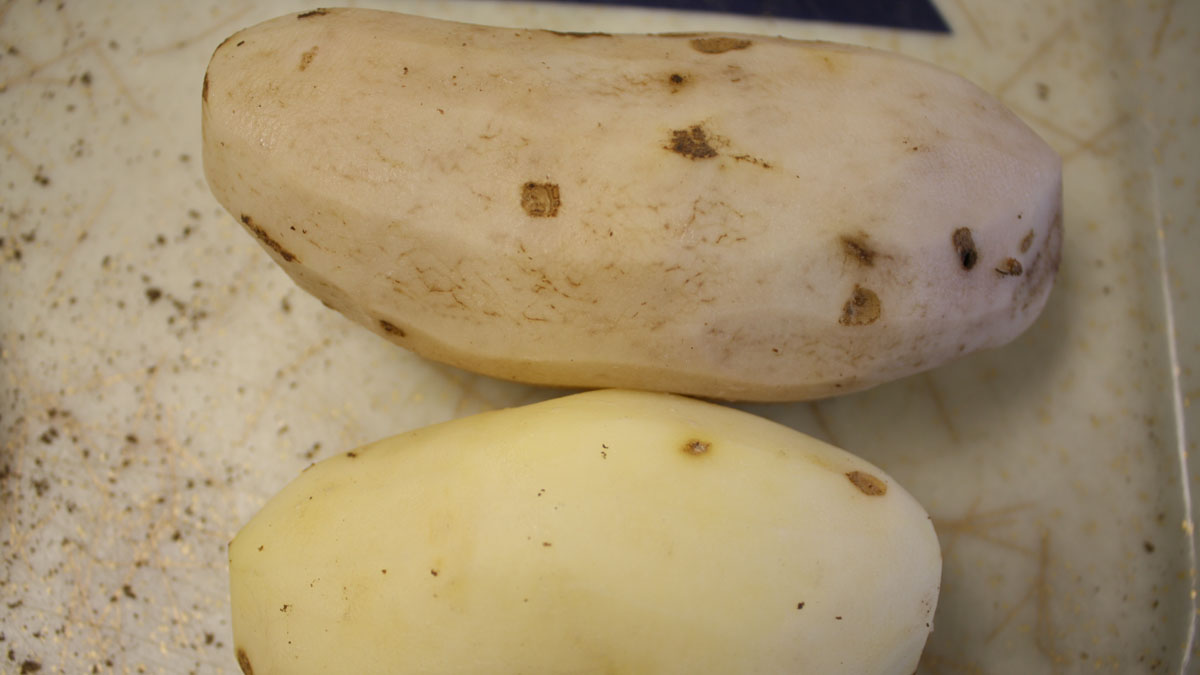Psyllid Management
Psyllids are small insects that suck plant juices. The adults resemble miniature cicadas and are related to cicadas, leafhoppers and aphids. Several different psyllid species are pests of various crops such as potato, tomato, pear and citrus. Only the potato psyllid is a pest of potato.
Description of Zebra Chip
The bacterium that causes zebra chip (ZC) produce necrotic flecking in the flesh of the tuber. The symptoms are similar to net necrosis (caused by Potato leafroll virus), but the symptoms of ZC often extend through the length of the tuber. When affected tubers are fried, the disease causes severe darkening of the chip or fry. The tuber defect is severe enough that the disease is a concern for both fresh and process potatoes.
Controlling infected potato psyllids is the primary way to control zebra chip. Non-infected psyllids will not cause zebra chip.
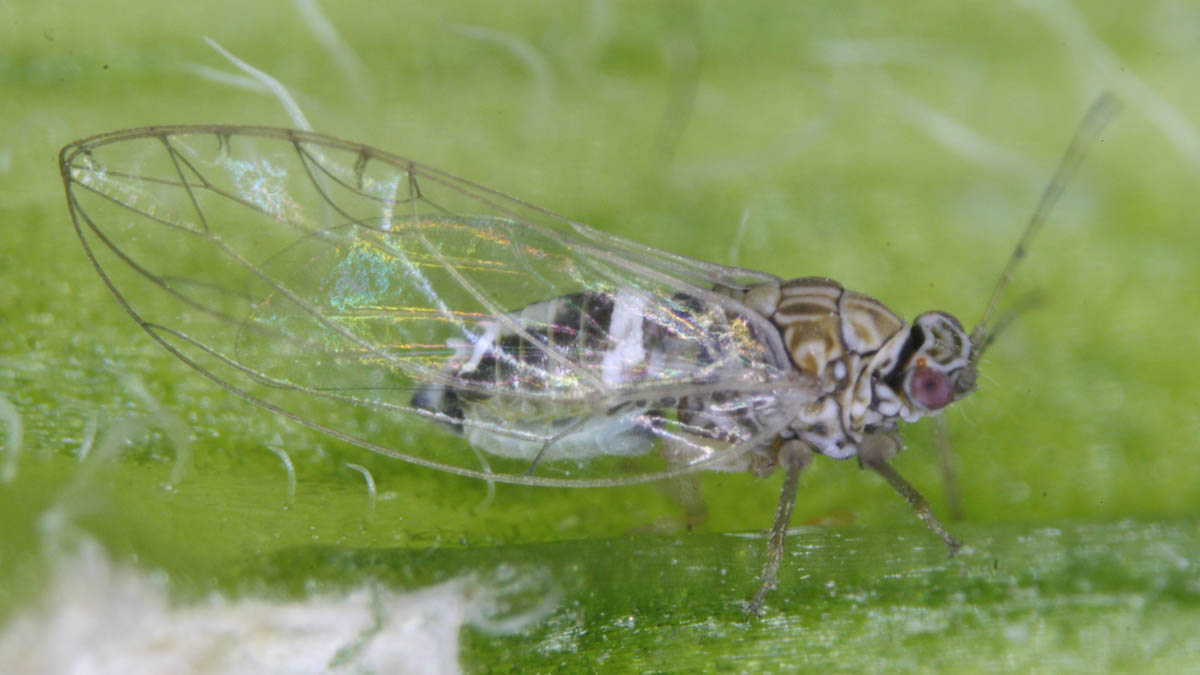
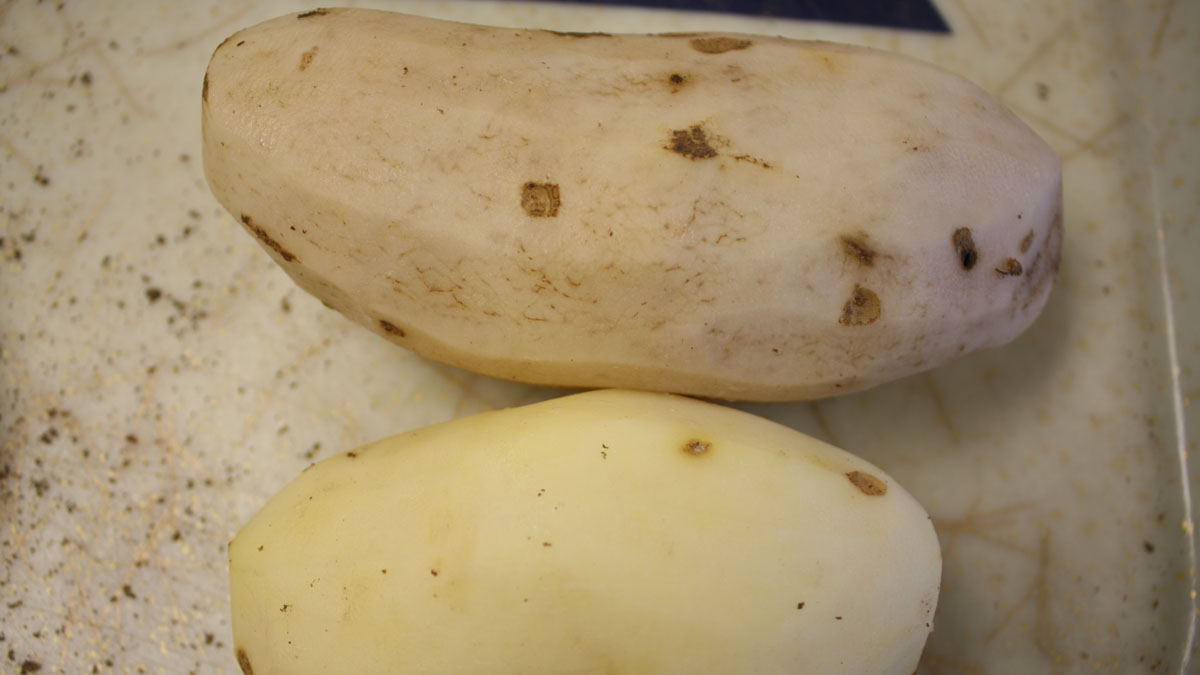
During 2011, zebra chip (ZC), a potato disease that was new to Idaho and the Pacific Northwest, was found in tuber samples from the Magic and Treasure Valleys. This disease is caused by a bacterium (“Candidatus Liberibacter solanacearum”; Lso) that is transmitted by potato psyllids.
During 2012, a monitoring program was initiated in order to clarify the extent and severity of the threat of ZC in Idaho. We have been sampling potato psyllids annually in commercial potato fields across the state and testing these psyllids for the presence of Lso. Patterns of the distribution and abundance exhibited by potato psyllids generally reflect the temperature and elevation gradient across the state. We typically record higher numbers of potato psyllids in the Treasure Valley (western Idaho) sites relative to Magic Valley (south-central Idaho) sites, and captures of potato psyllids in the Upper Snake region (eastern Idaho) generally are rare.
Incidences of Lso and ZC have not exhibited similarly clear patterns in their geographical distributions. ZC incidence has varied from year to year, but generally seems to reflect the abundance of both potato psyllids and Lso each year. ZC appears to be prevalent only when both high numbers of potato psyllids and Lso are recorded in our monitoring program. 2012 remains a standout year in this regard.
The University of Idaho has developed a scouting and information transfer program for the Idaho potato industry. Below is a summary of the program and recommendations.
- University of Idaho in collaboration with numerous crop consultants across the state has been conducting a potato psyllid monitoring program funded in part by the Idaho Potato Commission. We expect to continue this program each year, pending continued funding.
- Potato psyllids are sampled weekly using yellow sticky traps. Adult psyllids are tested for the presence of Lso by PCR.
- Alerts of updates on our potato psyllid and Lso monitoring program are posted during the growing season via the Pacific Northwest Pest Alert Network.
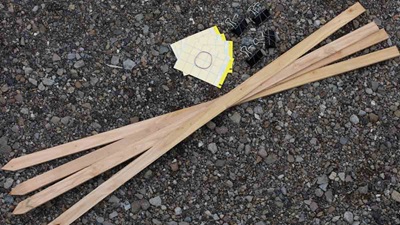 Various scouting techniques may be used to survey Idaho fields, with some methods being better for certain life stages. If you are considering your own potato psyllid scouting program, the best option may be using yellow sticky traps to monitor adults.
Various scouting techniques may be used to survey Idaho fields, with some methods being better for certain life stages. If you are considering your own potato psyllid scouting program, the best option may be using yellow sticky traps to monitor adults.
To detect the first psyllids, scouting should begin no later than mid-May. The date of initiation may need to be adjusted based upon timing of crop emergence.
You can either evaluate your samples for the presence of potato psyllids yourself or contact the Entomology program at the University of Idaho Kimberly Research and Extension Center, which offers psyllid identification as a fee for service.
If you choose to do your own identifications, photographs and key diagnostic characters of the different life stages of potato psyllids can be found at https://www.nwpotatoresearch.com/. You are encouraged seek confirmation of identifications via University of Idaho Extension.
- There are several sources or vendors for yellow sticky traps. Choose a vendor by price and service.
- Be sure to label each trap with as much detail as is needed to later identify where it came from. This likely will include the field name, date, and location in the field.
- Sticky traps must be placed within the field about 10 feet from the field edge to concentrate on the detection of potato psyllids and reduce the number of other harmless psyllid species on cards.
- Sticky traps need to be checked and replaced weekly since other insects and debris will accumulate on cards which make finding psyllids on the cards difficult.
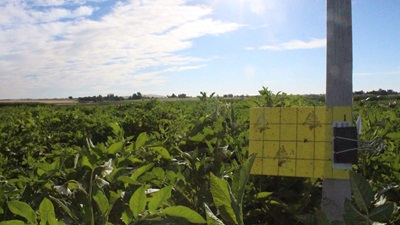 The traps can be easily attached to a wooden lath stake with a binder clip. Both sides of the trap have a piece of wax paper that is removed to expose the sticky part of the sticky trap.
The traps can be easily attached to a wooden lath stake with a binder clip. Both sides of the trap have a piece of wax paper that is removed to expose the sticky part of the sticky trap. - These sheets of wax paper need to be saved for later retrieval of the traps.
- As traps are replaced, remember to move the card upwards on the lath as the canopy grows (or downward as plants senesce), ensuring that the card is positioned just above the top of the canopy.
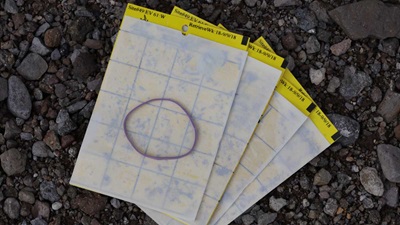 When retrieving traps, it is imperative that only the waxy side of the paper be re-adhered to the card face. The insects and debris collected on the trap typically allow the paper to stick well enough that it remains in place, allowing you to stack a set of traps together without them sticking to each other.
When retrieving traps, it is imperative that only the waxy side of the paper be re-adhered to the card face. The insects and debris collected on the trap typically allow the paper to stick well enough that it remains in place, allowing you to stack a set of traps together without them sticking to each other.- Video: Proper use and deployment of yellow sticky cards to monitor potato psyllids
Information/mapping of potato psyllid and zebra chip throughout Pacific Northwest. We will update and post information on potato psyllid detection throughout Washington, Oregon and Idaho to allow for tracking of the presence and movement of potato psyllids. Information will be reported by county only and all information will be kept confidential. Both the presence of potato psyllids and whether they are infected with the bacterium that causes zebra chip will be reported.
- See the following link for a complete list of insecticides registered in potatoes: https://pnwhandbooks.org/insect.
- Search for the most recent “Integrated Pest Management Guidelines for Insects and Mites in Idaho, Oregon and Washington Potatoes” report published on the Northwest Potato Research site https://www.nwpotatoresearch.com/ for specific insecticide recommendations.
- We encourage you to use psyllid monitoring information to inform your insecticide program.
- For areas of high risk, we recommend an at-planting application of a neonicotinoid insecticide (seed treatment, in-furrow or at-hilling), followed by a foliar insecticide program to target adult and nymph potato psyllids once the at-planting material nears the end of its efficacy period.
- For areas of lower risk, you may consider an at-planting or at-hilling neonicotinoid insecticide if it is not a part of your current insecticide program, and you may consider adjusting your foliar insecticide program if it does not already cover the period of psyllid incidence in potato fields.
- Note that some insecticides target adults, nymphs, eggs or all life stages. Select an insecticide that is most effective for the psyllid life stage requiring control measures as well as other insects that may be present at the time (e.g., Colorado potato beetles, aphids, mites, etc.).
- Avoid foliar neonicotinoid insecticide applications if this class of insecticide was used at planting or at hilling. This is important to avoid insecticide resistance. At-plant neonicotinoids have a long period of control, exposing susceptible insects for several weeks. This period and intensity of exposure may be adequate to foster insecticide resistance in psyllids or in Colorado potato beetles, aphids and other insect pests are also being affected by sprays targeting psyllids. Adding more foliar applications with the same class of insecticide will only increase this selection for resistance. Avoiding insecticide resistance is a critical part of psyllid management decisions.
- Avoid pyrethroid insecticides for potato psyllid control. Pyrethroids may flare potato psyllid populations by enhancing egg laying by females and/or killing beneficial insects that attack potato psyllids. Pyrethroids also may flare aphid and mite populations by similarly releasing them from control by natural enemies.
Recommendations for high-risk areas and/or highly risk-averse growers:
- We recommend an at-planting application of a neonicotinoid insecticide (seed treatment, in-furrow or at-hilling).
- Follow up with a foliar insecticide application to target adult and nymph potato psyllids once the at-planting material nears the end of its efficacy period. Refer to the “Potato Psyllid information and management guidelines” report published on the Northwest Potato Research site https://www.nwpotatoresearch.com/ for foliar insecticide recommendations. Note that some insecticides target adults, nymphs, eggs or all life stages. Select an insecticide that is most effective for the psyllid life stage requiring control measures as well as other insects that may be present at the time (e.g., Colorado potato beetles, aphids, mites, etc.).
- Avoid foliar neonicotinoid insecticide applications if this class of insecticide was used at planting or at hilling. This is important to avoid insecticide resistance. At-plant neonicotinoids have a long period of control, exposing susceptible insects for several weeks. This period and intensity of exposure may be adequate to foster insecticide resistance in any one (or more) of the pests in potatoes. Adding more foliar applications with the same class of insecticide will only increase this selection for resistance. It is important to remember that Colorado potato beetles, aphids and other insect pests are also being affected by sprays targeting psyllids. Relying too heavily on any one mode of action will select for resistance not only in potato psyllids, but in all of these pests. Avoiding insecticide resistance in these pests is a critical part of psyllid management decisions.
- Avoid pyrethroid insecticides for potato psyllid control. Pyrethroids may flare potato psyllid populations by enhancing egg laying by females and/or killing beneficial insects that attack potato psyllids. Pyrethroids also may flare aphid and mite populations by releasing them from control by natural enemies.
Recommendations for areas in Idaho that might be at lower risk for ZC:
- Follow traditional insecticide program previously used, but consider an at-planting or at-hilling neonicotinoid insecticide if it is not a part of your current insecticide program.
- Keep current on survey results in areas with positive detection of infected and non-infected potato psyllids.
- If at risk, follow a foliar program as described above and as outlined in the “Biology and Management of Potato Psyllid in Pacific Northwest Potatoes” report published in the Potato Progress.
Self Scouting
Proper use and deployment of yellow sticky cards to monitor potato psyllids







